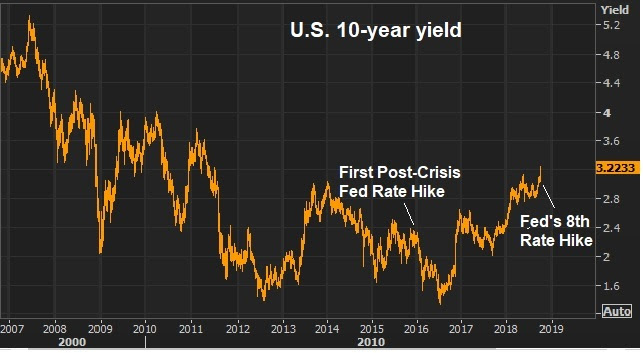If you are a regular reader of my daily notes, you’ll know I’ve suspected we are seeing an end to the “wild west” days in Silicon Valley.
I think we’ve finally seen it play out in the stock market in the past month.
The media has spent the past month pontificating about big macro economic stories and how these risks have driven this correction stocks. But the intermarket correlations don’t support it. Despite the sharp slide in stocks, money hasn’t fled to the safety of bonds. The currency market has shown little to no stress. And gold has been relatively quiet. This is all antithetical to what you would find in a world shaken from elevated global risks.
Ultimately, this correction has been about repricing the tech giants. And one of the power players in Silicon Valley said about as much this week.
Peter Theil, founder of PayPal and the first investor in Facebook said he doesn’t expect to see another innovative breakthrough consumer internet company. I agree (for a number of reasons).
With that, I want to revisit my note from March of 2017, as Trump was just getting his feet wet as President:
TUESDAY, MARCH 7, 2017
“A big component to the rise of Internet 2.0 was the election of Barack Obama.
With a change in administration as a catalyst, the question is: Is this chapter of the boom in Silicon Valley over?
Without question, the Obama administration was very friendly to the new emerging technology industry. One of the cofounders of Facebook became the manager of Obama’s online campaign in early 2007, before Obama announced his run for president, and just as Facebook was taking off after moving to and raising money in Silicon Valley (with ten million users). Facebook was an app for college students and had just been opened up to high school students in the months prior to Obama’s run and the hiring of the former Facebook cofounder. There was already a more successful version of Facebook at the time called MySpace. But clearly the election catapulted Facebook over MySpace with a very influential Facebook insider at work. And Facebook continued to get heavy endorsements throughout the administration’s eight years.
In 2008, the DNC convention in Denver gave birth to Airbnb. There was nothing new about advertising rentals online. But four years later, after the 2008 Obama win, Airbnb was a company with a $1 billion private market valuation, through funding from Silicon Valley venture capitalists. CNN called it the billion dollar startup born out of the DNC.
Where did the money come from that flowed so heavily into Silicon Valley? By 2009, the nearly $800 billion stimulus package included $100 billion worth of funding and grants for the ‘the discovery, development and implementation of various technologies.’ In June 2009, the government loaned Tesla $465 million to build the model S.
When institutional investors see that kind of money flowing somewhere, they chase it. And valuations start exploding from there as there becomes insatiable demand for these new ‘could be’ unicorns (i.e. billion dollar startups).
Who would throw money at a startup business that was intended to take down the deeply entrenched, highly regulated and defended taxi business? You only invest when you know you have an administration behind it. That’s the only way you put cars on the street in NYC to compete with the cab mafia and expect to win when the fight breaks out. And they did. In 2014, Uber hired David Plouffe, a senior advisor to President Obama and his former campaign manager to fight regulation. Uber is valued at $60 billion. That’s more than three times the size of Avis, Hertz and Enterprise combined.
Will money keep chasing these companies without the wind any longer at their backs?“
Again, this note above was from about 18 months ago. And administration change has indeed become a problem for these emerging monopolies.
Trump’s scrutiny has come, and so has the regulatory scrutiny. But admittedly is has taken longer than I expected.
Still, it has become clear now to lawmakers (in the U.S. and abroad) that the lack of regulatory oversight of these companies (if not regulatory favor) has created a “winner takes all” environment. And the power transfer into so few hands has quickly become a big threat.
Now these companies look forward to the next decade of regulatory purgatory. But given the maturity of these tech giants, higher regulation only strengthens their moat. That means there will never be a competition to Facebook emerging from a dorm room or garage. The compliance costs will be too high.
But regulation on the tech giants also creates the prospects for those “old-economy” competitors that have survived, to bounce back.









